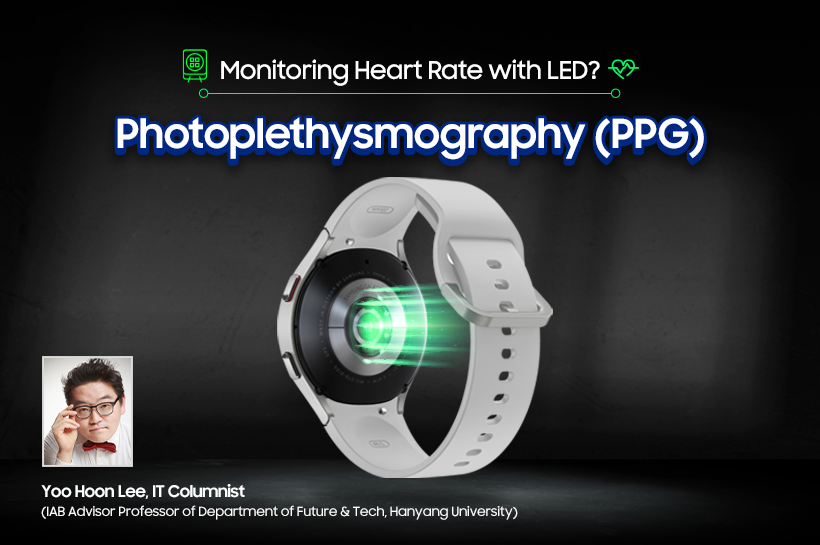
Tap the flashlight button on your smartphone and place a fingertip on it: Did you notice your finger turning red? Your ears, cheeks, and fingers all have thin skin, and light passes through them. This phenomenon inspired some scholars to ask: “Couldn’t we use this to monitor blood flow?” If we measure the amount of light that is absorbed by the blood, wouldn’t we be able to observe the changes in the volume of the blood?
It certainly took some time, but the efforts paid off in the end: The technology is now readily accessible. Underneath any smartwatch lies a Photoplethysmography (PPG), an optical sensor that measures blood volume changes in tissue.
Blood Pressure Monitoring Using PPG Sensor
How can we measure blood flow? Like the water ripples forming in the lake when rock skipping, similar effects take place in the blood vessels everytime the heart beats and pumps blood. This is referred to as Plethysmography (PTG). And it turns out that the velocity of PTG is higher than that of blood vessels: While it takes 1-2 seconds for the blood to reach the fingertip from the heart, it only takes 0.16 seconds for a PTG pulse wave to travel.
Photoplethysmography (PPG) is the analysis of the Plethysmography (PTG) waveforms. Because the velocity of PTG is affected by the condition of blood vessels (ex: thickness of the arteries, density of blood, etc.), this provides valuable insight about a person’s cardiovascular system. In fact, a consistent and accurate reading of PPG signals helps us monitor heart rate, which is a strong indicator of the overall health status.
Then how exactly can light measure blood flow? Pulse pressure changes caused by microscopic blood flow can be indicated by the amount of absorbed light from a PPG sensor. In other words, light absorption rate highlights blood volume variation. After all, Photoplethysmography (PPG) derived from the Greek words “Photo” (light), "Plethysmos" (increasing) and "Graphein" (to write).
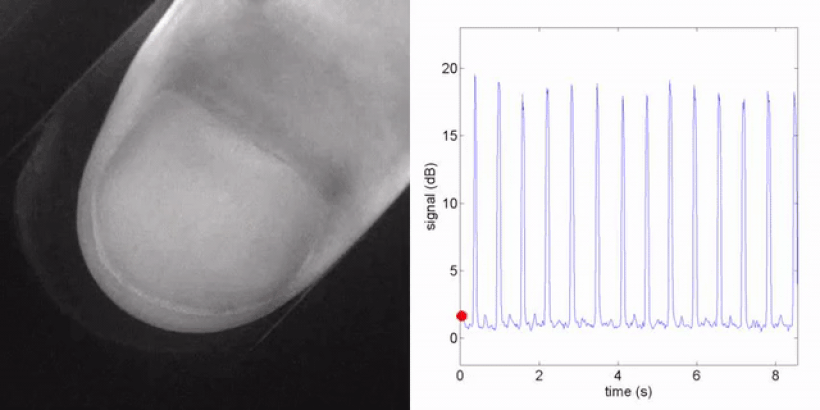
Saving lives with PPG Technology
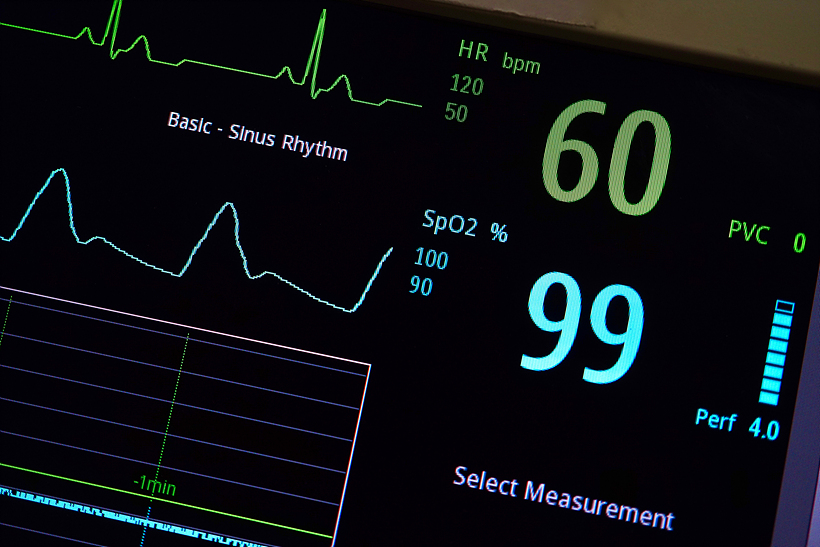
Who came up with the term Photoplethysmography (PPG)? PPG was first introduced in 1937 by Alrick B. Hertzman from the Department of Physiology at St. Louis University. His publication described the correlation between the amount of reflected light on the skin and blood volume changes as ‘PPG’. Due to its affordable and simple utilization of light detection tools, PPG was commercialized quickly. It’s also the reason why we no longer need to make incisions or injections of needles into the skin.
Pulse oximeters are an exemplary innovation based on PPG technology. Developed by Takuo Aoyagi in 1974, it became commercialized from 1983. Now, it is considered as one of the essential medical devices: Anytime you turn on a TV and watch a drama series with characters receiving treatment in intensive care units, you’ll notice pulse oximeters placed on their fingertips. Pulse oximeters contributed to oxygen saturation becoming one of the main vital signs routinely monitored by health care providers followed by body temperature, pulse rate, respiration rate, and blood pressure. During the peak periods of the coronavirus pandemic, oxygen saturation was also being used to detect severity among asymptomatic carriers.
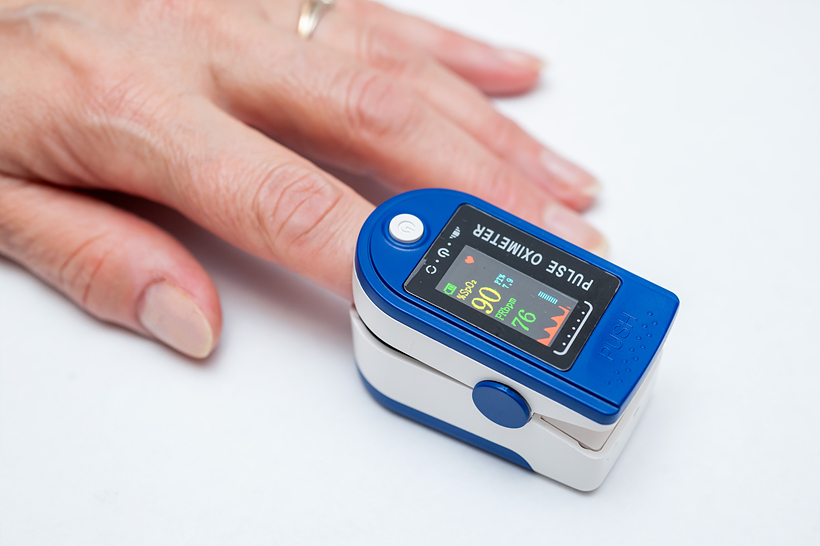
Does this mean that PPG measures oxygen saturation as well as blood flow? Yes. Using infrared/red light, oxygen saturation (SpO2) can be detected as blood flow changes occur. Difference in light absorption of oxygenated and non-oxygenated hemoglobin within red blood cells is the key measurement. For pulse wave velocity measurement, green instead of red light is used. While infrared/red light can make it difficult to measure blood flow since it gets affected by other types of light rays included in the sunlight, green light is well absorbed by red blood cells.
PPG Technology in Use
Implementation of PPG technology was not a smooth process despite its simplicity. Data investigation is needed as filtering out important information from the meaningless ones is crucial. Take the PPG sensor on smart watches as an example: PPG signals are susceptible to fluctuations due to factors such as skin color/body movement/tightness of watch strap/external light. It’s not always easy to stabilize PPG measurements by removing these noisy data. It was only after the evolution of digital signal processing and photoelectron technologies that led to the wider application of PPG technology.
In June 2021, Samsung Advanced Institute of Technology (SAIT) announced research results on stretchable OLED with a PPG sensor that changes form effortlessly in accordance with body movements. Even after being ‘stretched out’ a 1,000 times, the skin form factor functioned normally while measuring heart rate with high sensitivity. This result shows a promising future as a wearable device with usability. In fact, it is also being seen as a suitable component for future OLED stretchable displays due to its flexible organic sensors made of molecule-based electronic materials. Once commercialized, it might even become a “must-have” tech gadget in an aging society.
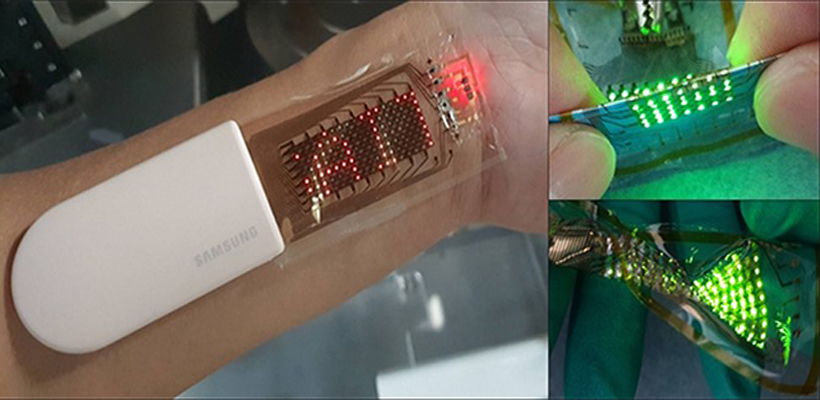
Apps that measure your heart rate for you exist. Just like smartwatches, these apps are utilized for health status measures. Welltory (Heart Rate Variability App) or FibriCheck (an FDA approved app for heart rhythm disorders) are both examples that integrate PPG technology with smartphone cameras. However, they are wellbeing services offering support for a balanced, stress-free life rather than medical devices. It has been reported to have resulted in similar data compared to other state-of-the-art external devices.
Of course there are also specialized medical devices with PPG technology, given that it has evolved with the development of health tools. Remote monitoring and biosensing software company Biospectal is said to debut its all-in-one blood pressure monitoring device Biodisc* at CES 2022. The fact that it runs by battery as well as being user-friendly makes it exceptional. Sky Labs** developed CART-I, which is a ring-type heart-monitoring device for measuring irregular pulse waves. Without any additional resources, the photoplethysmography (PPG) sensor in the ring monitors the bloodstream in the finger and records any alarming signs.
*It allows users to measure their vital signs via their fingertip using PPG sensors
**A vital signal big data based preventative healthcare company based in Korea
Photoplethysmography technology is often used in art works as demonstrated by ‘Pulse Topology’, an interactive light and sound art installation by Mexican Canadian media artist, Rafael Lozano-Hemmer. As participants walk into the dark venue, thousands of lights rhythmically glimmer to people’s heartbeats as they are integrated to the remote PPG sensors. It is a stunning media art installation.
Where you place the PPG devices matters. Measurements are taken preferably on the fingertips, wrists for smartwatches, and fingers for smart rings, but ear-worn devices and other forms of wearable PPG sensors (ex: ankles and head) are available. As a matter of fact, development of in-ear PPG pulse rate measurement is in place and we’ll most likely see earbuds with this new technology launched in 2022. Biometric sensor technology company Valencell plans to release its earbud heart-rate monitors.
There are various applications of PPG besides smartwatches. Recently, facial video-based PPG sensors such as GamSungTech’s ‘AI Heart Camera’ technology are in place. ‘HeartFit’ application uses facial recognition to monitor heart rate and other health information by simply having the user look into the camera for a minute. Another notable achievement is by Professor Jeffrey Olgin’s team at the University of California San Francisco (UCSF) - they used a smartphone's built-in camera with PPG sensors to detect Type 2 diabetes. An exciting future of real-time health monitoring systems using light nurturing healthy lifestyles around the world seems promising with the continuous advancements of the PPG technology.
※ This article holds the editor’s opinion, and Samsung Display Newsroom’s stance or strategies are not reflected.


